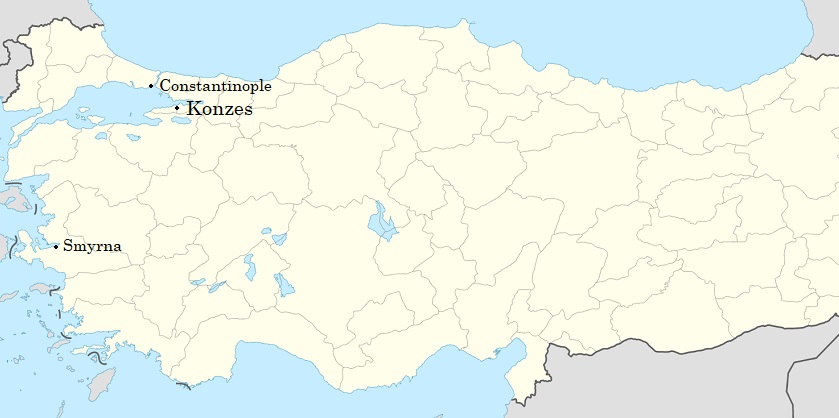
Map of current-day Turkey showing approximate location of Konzes. Base map credit NordNordWest
Konzes (Gr: Κοντζές) was a Greek settlement in the kaza of Karamürsel in the historic Bithynia (Gr: Βιθυνία) region of the Ottoman Empire. There were 220 affluent Greek families living there just prior to the genocide. Konzes was a beautiful seaside town which during Summer served as a holiday destination for the wealthier residents of the region.
On the 18th of February 1921, Kemalist regular forces under the command of Djemal of Nicaea (Iznik), as well as irregulars and the police entered Konzes and began looting the homes and stores. Two thousand men, women and children from the neighboring Turkish towns joined in the looting, shouting and singing as they grabbed possessions belonging to Greeks, taking them away on animals, row boats and sail boats. Greeks were dragged into the mountains while others were slaughtered in the streets. The village was ultimately burned to the ground. The Hellenic Army arrived in the region on the 20th of February 1921 and as they approached Konzes, they found the land covered with corpses, male and female clothing, hands, feet, noses, ears and fingers. Hellenic war correspondent Kostas Faltaits arrived at Konzes in June 1921 and witnessed the ashes from the razed town. He noticed a strong odor coming from the ruins and cinders of homes; evidence that the corpses of the unfortunate inhabitants had not yet fully decomposed.1
1. Faltaits, K, The Genocide of the Greeks in Turkey: Survivor Testimonies from the Nicomedia (Izmit) Massacres of 1920-1921. Cosmos 2016, pp. 75-80.
2. Reports on Atrocities in the Districts of Yalova and Guemlek and in the Ismid Peninsula. London, 1921, p. 11.
Further reading:
The Massacre of Greeks at Fulacik, June 1920.
The İznik (Nicaea) Massacre, August 1920
These are the Turks
Ortakoy, Bithynia: The Massacres and the Uprooting



